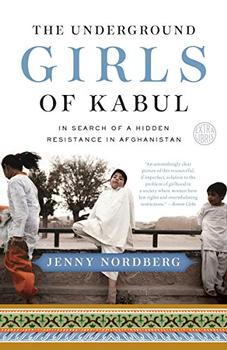Summary | Excerpt | Reading Guide | Discuss | Reviews | Beyond the Book | Read-Alikes | Genres & Themes | Author Bio

In Search of a Hidden Resistance in Afghanistan
by Jenny NordbergThis article relates to The Underground Girls of Kabul
The Underground Girls of Kabul explores the custom of bacha posh where girls are dressed as boys and pass off as sons in families. While, by definition, the bacha posh wear male clothing, I thought this would be a good opportunity to explore the various items of Muslim women's attire as I suspect that, like myself, many readers will be unclear about the differences between the various garments, such as the hijab, chador, abaya and burka:
 The practice of wearing a veil or head covering predates Islam; statues from approximately 2500 BCE depict veiled women, and the first written reference found is in an Assyrian legal text composed in the 13th century BCE. It's thought that the custom was common in Persia and Byzantine societies, meant to differentiate between respectable women and those who were of lower class (in some places it was illegal for slave women or prostitutes to wear a veil). As the Muslims conquered the Middle East they assimilated the practice, adopted first among the highest class of women and eventually trickling down to commoners.
The practice of wearing a veil or head covering predates Islam; statues from approximately 2500 BCE depict veiled women, and the first written reference found is in an Assyrian legal text composed in the 13th century BCE. It's thought that the custom was common in Persia and Byzantine societies, meant to differentiate between respectable women and those who were of lower class (in some places it was illegal for slave women or prostitutes to wear a veil). As the Muslims conquered the Middle East they assimilated the practice, adopted first among the highest class of women and eventually trickling down to commoners.
Followers of Islam cite passages in the Qur'an that encourage modest dress among its adherents:
The believing men are enjoined to lower their gaze and conceal their genitals and the believing women are enjoined to lower their gaze and conceal their genitals, draw their headdress to cover their cleavage, and not to display their beauty, except that which has to be revealed, except to their husbands, their fathers, their husbands' fathers, their sons, their husbands' sons, their brothers or their brothers' sons, or their sisters' sons, or their women, or their slaves, or eunuchs or children under age; and they should not strike their feet to draw attention to their hidden beauty. O believers, turn to God, that you may know bliss. (Qur'an 24:30-31)
O Prophet! Enjoin your wives, your daughters, and the wives of true believers that they should cast their outer garments over their persons (when abroad): That is most convenient, that they may be distinguished and not be harassed. (Qur'an 33:58–59)

The purpose of wearing concealing clothing is said to create a distinction between one's public and private life, protecting the latter from outsiders and guarding honor. There is a wide variety of opinion with regard to women's apparel and what constitutes appropriate dress, however. This has led to different types of clothing designed to protect a woman's modesty and declare her dedication to Islam:
The practice of wearing hijab had begun to wane but experienced a resurgence starting in the mid-20th century as a reaction to the increasing westernization of the Middle East. Young women began adopting the veil more frequently as a protest against western values and as a recommitment to the Islamic faith. Over time it became the norm (and mandated in some places) as more religiously conservative governments came into power.
Many women in non-Islamic countries today choose to wear hijab, saying that it's liberating and provides an increased sense of identity.
Two popular ways to wear the hijab: Al-Amira and the Shayla from Beliefnet
Pictures of the different hijab styles from Enamorate De Dubai
Filed under Places, Cultures & Identities
![]() This "beyond the book article" relates to The Underground Girls of Kabul. It originally ran in October 2014 and has been updated for the
July 2015 paperback edition.
Go to magazine.
This "beyond the book article" relates to The Underground Girls of Kabul. It originally ran in October 2014 and has been updated for the
July 2015 paperback edition.
Go to magazine.
Your guide toexceptional books
BookBrowse seeks out and recommends the best in contemporary fiction and nonfiction—books that not only engage and entertain but also deepen our understanding of ourselves and the world around us.